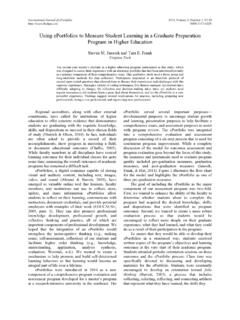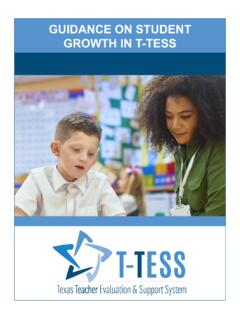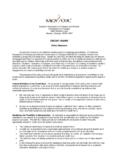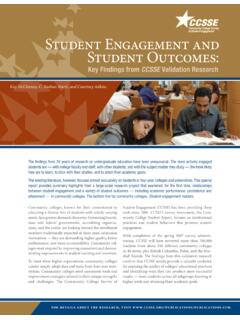Transcription of How to Measure the Performance of Your Outreach Programs
1 How to Measure the Performance of Your Outreach ProgramsApril 2006 About DeHavilland AssociatesDeHavilland Associates is a consulting and communications fi rm that helps its corporate, nonprofi t, and association clients understand and connect with the K-12 community. Th e company designs, manages, and evaluates Outreach campaigns and partnership Programs for its clients and creates original initiatives to help educators and education stakeholders establish and strengthen dialogue for the benefi t of public more information, visit the Business/Education Partnership ForumCreated and managed by DeHavilland Associates, the Business/Education Partnership Forum is an online clearinghouse for anyone interested in learning how to build eff ective business/education partnerships.
2 Th is clearinghouse off ers news and announcements, links to resources, a directory of organizations involved in business/education partnerships, and a monthly more information, visit the Eff ective Education Partnerships ConferenceTh e Eff ective Education Partnerships Conference (EEPC) is an annual two-day meeting for the practitioners of business/education partnerships, including chambers, business coalitions, individual businesses, school and district leaders, and others interested in hearing case studies and eff ective practices from others in the fi eld. EEPC will be held July 10-11, 2008 in Fairfax, more information, visit content 2007, DeHavilland Associates. All rights reserved. measuring Outreach Performance April 2006 | 1 Today s schools operate in an era of accountability, grappling with the requirements and consequences of tracking and reporting results.
3 Th ose who manage education Outreach initiatives fi nd themselves under similar pressure: they are increasingly being required to demonstrate how eff ectively they use resources, and how they provide a return to the sponsoring organization. For education Outreach Programs , this mandate is a positive step forward. It indicates that education Outreach is now being considered to be just as important as any other HR, PR, or corporate relations function and, as a result, is being held to the same Performance and accountability standards. Th is is a key step on the road to an ongoing, if not increasing, investment in such Programs . It also means that education Outreach Programs will create ever-greater impacts on education due to the cycle of continuous improvement that this type of measurement and analysis makes is paper will provide an introduction to campaign tracking and measurement, help you to identify the metrics appropriate to your program model, and provide formulas and commentary for using them eff First Step in Performance MeasurementTh e fi rst and most important step in setting up an eff ective measurement component comes as the overall campaign is being planned.
4 Measurement must be included as an integrated component from the outset: campaign goals should be determined in part by what can be measured in both quantitative and qualitative terms, and measurement requirements should be integrated into each campaign component (such as collecting email addresses from prospective users so they can be surveyed later). Some principles to consider in designing your measurement strategy: Clearly identify each audience you wish to reach. While your education Outreach initiative will certainly center on teachers and students, many campaign sponsors also wish to reach other audiences such as parents, customers, the media, legislators and regulators, and employees in order to maximize returns on their eff orts. Determine your desired outcomes for each audience.
5 How many members of each audience do you wish to reach? What do you want those people to know, think, or do as a result of your campaign? Next to each desired outcome for each campaign audience, identify the way(s) in which that outcome can and will be measured. You can use quantitative measurements to determine things like media impressions, inquiry rates, contest entry submissions, or volunteer hours logged. Tools such as audience surveys can be used to capture data such as opinions and perceptions, including perceived value and engagement on the part of participants as well as perceptions of the program and sponsoring company on the part of external audiences. Make sure you have systems in place to capture quantitative data, such as number of website visits, inquiries received, or media impressions.
6 Some types of measurements can be impossible to calculate after the fact. Build survey tools you ll use to capture qualitative data such as participants perception of the value and experience of the program. To minimize the potential for survey bias, bring in a qualifi ed and independent reviewer to look over and revise your surveys. And, if at all possible, pre-test your surveys with a sample of your audience to make sure they can clearly understand the questions. Establish benchmarks for any measurements intended to refl ect your program s impact. If you want to your program s impact on student knowledge of global warming, for example, you need to determine what they knew before being exposed to the program. Similarly, if you want to Measure the eff ect of your program on your customers perception of your company, you ll need to capture data on their opinions and feelings before your program is the Performance of Your Outreach ProgramsA primer on promoting your eduction Outreach program through an array of channels2 | measuring Outreach Performance April 2006Th e remaining sections of this paper identify key areas you may wish to consider for tracking and measurement, and provide introductory information and some equations to help you build your systems and campaigns involve an acquisition component, whether that involves recruiting teachers to request materials, students to participate in a contest.
7 Or employees or community members to participate with volunteer hours. Determining which tools and channels are the most eff ective and cost-effi cient allows you to use your money wisely and to predict future participation rate is a fundamental metric for any mass marketing initiative that requires action on the part of interested audience members. Th ere are several factors that can aff ect response rate, including list selection, messaging, and creative elements, and by instituting a tracking program and testing various combinations of those elements (a method known as split run testing), you will be able to determine which combination of marketing elements off ers you the greatest return. A campaign s response rate does not have to be restricted to a single composite measurement: it can be very helpful to Measure response rate by channel, which can help you determine the most productive means of reaching your target audience.
8 Channels such as online marketing, advertising, direct mail, telemarketing, and conference exhibitions allow you to communicate with prospective users in diff erent ways, and you may fi nd that some channels are particularly eff ective in generating response to your course, response rates only off er a partial picture: the costs associated with each channel, or even with each vehicle within a channel, can vary widely, and those costs must be taken into account when considering the relative value of using a particular channel or vehicle. Determining cost per prospect, particularly when calculated by source, will help you identify the best Outreach opportunities for your , while cost per prospect by source off ers valuable data, don t forget that there are few channels or marketing vehicles that off er total access to the market.
9 For example, online marketing may off er you the lowest cost per prospect: however, you shouldn t necessarily commit your entire Outreach budget there, since this channel can only off er you access to a portion of your total audience. A prudent Outreach plan takes into account not only response rates and costs, but also the percentage of the market that a channel or vehicle allows you to reach. To fully penetrate the market, you must call on a combination of marketing opportunities. If your campaign incorporates a two-step acquisition process, whereby prospective users request information and then must take an additional step to register or to participate, calculating that conversion rate is essential to generating a thorough analysis. Online targets, for example, may request information at a very high rate but convert poorly, lessening the true value of this channel despite any perceived cost effi acquisition focuses on specifi c actions taken by targeted audience, exposure is a broader Measure of understanding and awareness made possible by your campaign.
10 Th is may be more appropriate for information campaigns targeted at your primary audience, such as a stay in school in-school advertising initiative, or it may be used in targeting secondary audiences, such as customers or the public. You can use reported media numbers, such as impressions, to gauge exposure among targeted audiences. Impressions are simply the number of readers or viewers reported by the media outlet carrying your message, such as the ratings claimed by television Programs or readership statistics highlighted by magazines or newspapers. For most media, these are estimates: you won t be able to defi nitively state how many people saw your public service announcement during a commercial break. Online media, however, can off er specifi c data on page views, time spent per page, and teachers, students, and other relevant audiences (parents, volunteers, etc.)








